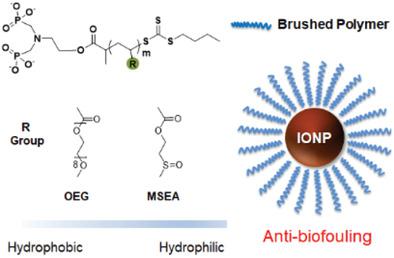Our official English website, www.x-mol.net, welcomes your
feedback! (Note: you will need to create a separate account there.)
Sulfoxide-Containing Polymer-Coated Nanoparticles Demonstrate Minimal Protein Fouling and Improved Blood Circulation.
Advanced Science ( IF 14.3 ) Pub Date : 2020-05-17 , DOI: 10.1002/advs.202000406 Ruirui Qiao 1, 2 , Changkui Fu 1 , Yuhuan Li 2 , Xiaole Qi 3 , Dalong Ni 4 , Aparna Nandakumar 2 , Ghizal Siddiqui 5 , Haiyan Wang 6 , Zheng Zhang 6 , Tingting Wu 7 , Jian Zhong 7 , Shi-Yang Tang 8 , Shuaijun Pan 9 , Cheng Zhang 1 , Michael R Whittaker 2 , Jonathan W Engle 4 , Darren J Creek 5 , Frank Caruso 9 , Pu Chun Ke 2 , Weibo Cai 4 , Andrew K Whittaker 1 , Thomas P Davis 1, 2
Advanced Science ( IF 14.3 ) Pub Date : 2020-05-17 , DOI: 10.1002/advs.202000406 Ruirui Qiao 1, 2 , Changkui Fu 1 , Yuhuan Li 2 , Xiaole Qi 3 , Dalong Ni 4 , Aparna Nandakumar 2 , Ghizal Siddiqui 5 , Haiyan Wang 6 , Zheng Zhang 6 , Tingting Wu 7 , Jian Zhong 7 , Shi-Yang Tang 8 , Shuaijun Pan 9 , Cheng Zhang 1 , Michael R Whittaker 2 , Jonathan W Engle 4 , Darren J Creek 5 , Frank Caruso 9 , Pu Chun Ke 2 , Weibo Cai 4 , Andrew K Whittaker 1 , Thomas P Davis 1, 2
Affiliation

|
Minimizing the interaction of nanomedicines with the mononuclear phagocytic system (MPS) is a critical challenge for their clinical translation. Conjugating polyethylene glycol (PEG) to nanomedicines is regarded as an effective approach to reducing the sequestration of nanomedicines by the MPS. However, recent concerns about the immunogenicity of PEG highlight the demand of alternative low‐fouling polymers as innovative coating materials for nanoparticles. Herein, a highly hydrophilic sulfoxide‐containing polymer—poly(2‐(methylsulfinyl)ethyl acrylate) (PMSEA)—is used for the surface coating of iron oxide nanoparticles (IONPs). It is found that the PMSEA polymer coated IONPs have a more hydrophilic surface than their PEGylated counterparts, and demonstrate remarkably reduced macrophage cellular uptake and much less association with human plasma proteins. In vivo study of biodistribution and pharmacokinetics further reveals a much‐extended blood circulation (≈2.5 times longer in terms of elimination half‐life t 1/2) and reduced accumulation (approximately two times less) in the organs such as the liver and spleen for IONPs coated by PMSEA than those by PEG. It is envisaged that the highly hydrophilic sulfoxide‐containing polymers have huge potential to be employed as an advantageous alternative to PEG for the surface functionalization of a variety of nanoparticles for long circulation and improved delivery.
中文翻译:

含亚砜聚合物涂层的纳米颗粒显示出最小的蛋白质污染并改善了血液循环。
最大限度地减少纳米药物与单核吞噬系统(MPS)的相互作用是其临床转化的关键挑战。将聚乙二醇(PEG)与纳米药物结合被认为是减少 MPS 对纳米药物封存的有效方法。然而,最近对 PEG 免疫原性的担忧凸显了对替代低污染聚合物作为纳米颗粒创新涂层材料的需求。在此,一种高亲水性的含亚砜聚合物——聚(2-(甲基亚磺酰基)乙基丙烯酸酯)(PMSEA)——被用于氧化铁纳米粒子(IONP)的表面涂层。研究发现,PMSEA 聚合物包被的 IONP 比 PEG 化的 IONP 具有更亲水的表面,并且巨噬细胞的摄取显着减少,与人血浆蛋白的关联也大大减少。生物分布和药代动力学的体内研究进一步揭示了肝脏和脾脏等器官中的血液循环大大延长(消除半衰期t 1/2长约2.5倍)和蓄积减少(约少两倍) PMSEA 包覆的 IONP 优于 PEG 包覆的 IONP。据设想,高亲水性的含亚砜聚合物具有巨大的潜力,可作为 PEG 的有利替代品,用于各种纳米颗粒的表面功能化,以实现长循环和改善递送。
更新日期:2020-07-08
中文翻译:

含亚砜聚合物涂层的纳米颗粒显示出最小的蛋白质污染并改善了血液循环。
最大限度地减少纳米药物与单核吞噬系统(MPS)的相互作用是其临床转化的关键挑战。将聚乙二醇(PEG)与纳米药物结合被认为是减少 MPS 对纳米药物封存的有效方法。然而,最近对 PEG 免疫原性的担忧凸显了对替代低污染聚合物作为纳米颗粒创新涂层材料的需求。在此,一种高亲水性的含亚砜聚合物——聚(2-(甲基亚磺酰基)乙基丙烯酸酯)(PMSEA)——被用于氧化铁纳米粒子(IONP)的表面涂层。研究发现,PMSEA 聚合物包被的 IONP 比 PEG 化的 IONP 具有更亲水的表面,并且巨噬细胞的摄取显着减少,与人血浆蛋白的关联也大大减少。生物分布和药代动力学的体内研究进一步揭示了肝脏和脾脏等器官中的血液循环大大延长(消除半衰期t 1/2长约2.5倍)和蓄积减少(约少两倍) PMSEA 包覆的 IONP 优于 PEG 包覆的 IONP。据设想,高亲水性的含亚砜聚合物具有巨大的潜力,可作为 PEG 的有利替代品,用于各种纳米颗粒的表面功能化,以实现长循环和改善递送。











































 京公网安备 11010802027423号
京公网安备 11010802027423号